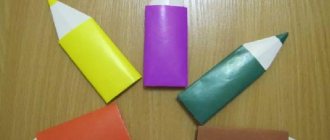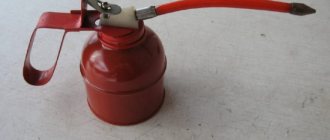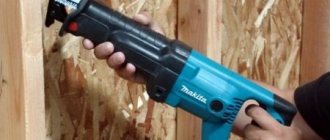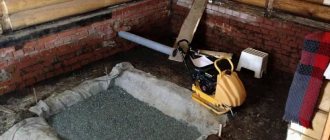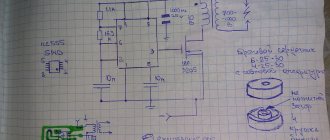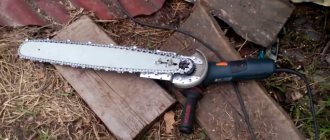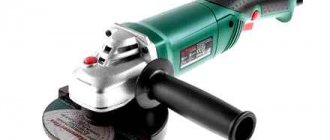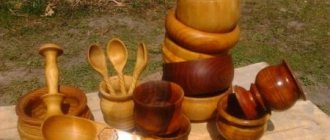Materials and tools for making an espresso coffee machine
Copper parts
- Two plugs with a diameter of 1″
- Four plugs with a diameter of 1/2″
- One tube with a diameter of 1/2″, 75 mm long
- 3 fittings with a diameter of 1/2″ (two of them will be used for making filters)
- One 1″ diameter fitting
- Adapter from 1 to 1/2″ (1″ is male). The adapter will be used to make a teapot
- Adapter from 1 to 1/2″ (1″ - female). The adapter will be used to make the boiler.
- One copper tube with a diameter of 1/4″, about 100 mm long.
Fasteners
- 6mm bolt 75mm long
- 6mm wing nut
For the filler hole: small bolt and nut. The length of the bolt should not be more than 12 mm, the height of the nut should be about 10 mm.
For the heater: small bolt and nut. The diameter of the bolt should be less than the diameter of the 1/4 inch copper tube. The length of the bolt is about 12 mm.
Additional details
- Two rubber gaskets with a diameter of 1″
- Two rubber O-rings used on faucets. The rings are needed to seal the filler hole and the hole under the wing nut
- 10cc syringe
- A small board.
Tools
- Drill
- Hacksaw
- Soldering iron
- Sandpaper No. 150
- Wire cutters
- Pliers
- Hammer
- Drills (diameter 6, 3 and 1.5 mm)
- A few small nails.
How to brew coffee in a coffee maker
Brewing coffee is not difficult if you first get acquainted with all the variety of machines in the coffee world. How to use a coffee pot and how to prepare a delicious drink?
Drip
Drip coffee machines can be used in a large family when it is necessary to prepare many servings of an aromatic drink at once. A drip coffee maker works on the principle of passing hot steam through ground coffee beans and special filters. This is ideal for Americano. The prepared drink drips into a common jug, from which it is then poured into cups.
The drip coffee machine is suitable for a large family.
The device has a heating function, so the container with ready-made coffee can remain hot for a long time:
- pour the required amount of water according to the scale on a special container;
- pour the required amount of ground coffee into the filter;
- set the program;
- Depending on the model, the coffee will be dispensed into a separate flask or directly into the cup.
In this device, coffee stays hot for a long time.
Capsule
A capsule coffee maker offers a convenient selection of ready-made drinks. Here you can brew latte, Americano, cappuccino and others. The preparation process begins with placing a portioned capsule with ground coffee. Its packaging is pierced and hot water is forced through the ground grains under high pressure. The strength and taste of the finished drink will directly depend on the selected pressure. Of course, you have limited choice in capsule manufacturers.
You can make ready-made drinks in a capsule coffee maker.
But you can choose your own brand that fully meets your requirements and taste preferences:
- turn on the machine and fill in the required amount of water;
- place the capsule in a special receiver;
- Place the cup and wait until the finished drink comes out of the nozzle.
After preparation, the coffee is served in a glass.
Geysernaya
The geyser coffee maker is designed for lovers of strong and rich coffee taste. The drink does not need to be further strained or settled, since this preparation method does not leave sediment in your cup. Hot water is passed through the poured coffee under the influence of steam.
A geyser coffee maker produces a coffee drink without sediment.
The coffee pot is easy to use, easy to disassemble and clean from grounds:
- pour water into the lower compartment to the desired level;
- pour ground powder into a special funnel;
- assemble the device according to the instructions and plug it into the network;
- under steam pressure, the coffee drink will flow into the upper container;
- after the machine is turned off, the drink is poured into the cup.
The device is quite easy to use.
Rozhkova
This coffee maker got its name thanks to its removable horns. These are models for gourmets, those who like to experiment with drinks and professional baristas. Ground coffee is poured into the cone and compacted as much as possible. Here you yourself vary the grinding size of the beans, cooking time, water temperature and other factors. Each time you will receive a finished drink that is different in taste and strength.
A carob coffee maker allows you to experiment with flavors.
You can create rich foam, wonderful espresso and balanced cappuccino:
- if the model is equipped with a function for self-grinding beans, then pour them into a special container;
- Place ground coffee in the cone and press firmly;
- set the required parameters for water temperature, pressure supply and others;
- place a cup under the nozzle spout;
- If desired, froth the milk using a cappuccino maker.
If desired, you can make a thick foam.
Which acid to choose
The ideal solution in the fight against calcified formations on the walls of the coffee machine is vinegar. It contains acetic acid, which is a weak organic acid.
The substance can treat internal surfaces even with a minimum volume. Appropriate amounts of vinegar should be applied depending on the degree of contamination of the stone.
Vinegar is a natural and toxic waste-free product. Its acidic properties help get rid of scale, mineral deposits and even the coffee oil left behind from the beans. Citric acid also helps in the fight against scale.
In other cases, special chemicals that are sold in stores and supplied in liquid or crystalline form will help. They most often contain organic sulfamic acid, which is an excellent product for a coffee machine and much safer for various types of metals.
Many acids that are used to combat plaque can sometimes have negative effects on the skin if you are not careful. Therefore, rubber gloves should be used when cleaning the coffee machine.
Most Nespresso models have programmed cleaning processes to remove scale. In this case, you should simply use cleaning products and select the appropriate button on the machine, which will start the process. If there is no such program, descaling the Nespresso coffee machine is carried out using available means.
The procedure consists of the following steps: filling the reservoir with water with the addition of a certain cleaning agent. Then you should turn on the coffee machine to brew coffee so that the liquid passes through all the working elements of the equipment, cleaning them from deposits.
Details on how to descale a Nespresso Citiz capsule coffee machine (video):
What is a coffee machine
This is a type of household appliance that is used at home. It is capable of preparing not only traditional black coffee, but also other drinks based on it. The machine is fully automated, manual control is allowed, but only minimal
Knowing how to choose the right coffee machine for your home is important; the quality of the desired drink will depend on it
There are many types of coffee machines. Each of them has its own characteristics and capabilities. Many models can and do perform the following list of actions:
- grind coffee beans;
- determine the required ratio of water and raw materials for brewing;
- change the grind size;
- form briquettes from coffee powder;
- they heat the water, then passing it or its vapor through the coffee;
- remove the already used grinding into a specially designated tank;
- can prepare not only black, but also other types of coffee;
- can self-clean;
- automatically ends the process when the coffee is ready.
People very often confuse a coffee machine with a coffee maker. These are two completely different devices. The first device is completely automated, preparing coffee from start to finish without human intervention. The second one works completely differently. Here the person himself pours in the required amount of ground coffee, pours it with water and, heating it on the stove, waits for the drink to be prepared.
What determines the taste of brewed coffee?
It is not always possible to brew espresso as tasty as we would like. This is due to the fact that the use of coffee makers has certain features. The taste of the prepared drink is influenced by several factors:
- water. You need to use clean, purified or bottled. The presence of impurities is unacceptable;
- grinding degree. The finer the coffee fractions, the stronger the drink;
- dosage. The strength directly depends on the selected proportions of crushed grains and water;
- preheating the dishes. If the finished espresso is poured into a warm container, it fully reveals its taste and aroma qualities.
Popular models and manufacturers
Popular brands are fighting for the right to be first in the world of specialized coffee machines. There are several manufacturers that successfully occupy first positions in the market for sales of coffee makers and coffee machines:
- The Italian concern DeLonghi is distinguished by its minimalist equipment design. And their coffee machines amaze with their rich functionality. For example, the famous model ECAM 44.664.B has an automatic cleaning system for the device.
- The Italian brand Saeco confidently holds the first position among manufacturers of high-quality coffee makers for the home. The Incanto HD8918/09 model has 5 programs for the strength of ready-made drinks.
- Philips relies on futuristic design and high quality coffee machines.
- Among the domestic brands, one can note the Polaris coffee maker. Instructions for use, intuitive operation and sophisticated design have made it a top seller.
Patented version of a homemade coffee machine
Let us note right away: the answer to the question of how to make a full-cycle coffee machine with your own hands has not been found. The most effective option involves separating operations. A grain mill is made separately; the simplest solution can be a steel screw installation for grinding spices. There are also devices with electric and manual drive, but there is not much difference between them.
The prepared ground coffee is poured into a homemade coffee maker. One of the interesting developments, for which a patent has even been received, is a device designed by engineer Vladimir Oreshkin. This is a durable, double-walled chamber made from solid billet and equipped with an outlet for draining the finished drink.
To prepare espresso, place a steel container with water inside and add a portion of ground coffee. The lid closes securely, it does not have sealing gaskets - the grinding principle is implemented. When the container is heated, the full effect of steaming the coffee is observed, which allows you to achieve the rich taste and aroma of espresso. The original model of the homemade coffee maker was designed to be installed on a gas stove.
Based on this development, many craftsmen have come up with improved versions of coffee makers. They added their own heaters, both electric and using alcohol and paraffin burners.
Controversial designs
On the Internet you can find more than one or two options for making a coffee machine with your own hands. For example, a mini-coffee maker for making espresso wanders from forum to forum, which has everything: its own alcohol burner for heating water, a container for coffee, and a convenient faucet for draining the drink. At the same time, the device can be easily placed in a pocket. You can see this mini coffee maker in the photo.
However, a specific design requires the use of welding, copper tubes, unique components, and empirically selected sizes. Therefore, it is impossible to guarantee that everyone can make this coffee maker. Particularly because an alcohol burner is used as a heater, but no parameters for modifying the device for using kerosene, gasoline or paraffin are given.
There are also successful projects that look almost like a serial industrial product, for example, there is a lively discussion on the Internet about a stylish coffee maker from a German artisan.
Its design contains many components taken from different devices: coffee mills, heaters, even a housing from a household appliance. The product is unique, and attempting to replicate it may not always be successful.
How to make latte macchiato
Description and other features
In addition to the classic recipe, there is an alternative one, which is described in the article “What is latte macchiato.” Next, we will consider only the basic nuances and how to make a drink in a coffee machine.
"Macchiato" means "spot" in Italian. The barista gave this name to the drink because of its appearance. After ready-made espresso is poured into hot milk, brown spots remain on the surface. In the bar menu you can find the name “macchiato”.
Interesting! Why can coffee sour?
This coffee can be prepared at home in a Delonghi, Krups and Bork coffee machine.
The main difference between a latte macchiato and a standard drink is the order of ingredients - milk is poured into the glass first.
This latte recipe features a large volume of milk - the ratio to coffee is 3:1. And also a high top layer - a third of the volume of the entire portion.
Recipe
Brew a shot of espresso. Prepare the foam as in the standard method and pour it into a tall glass 2/3 full.
Carefully pour the espresso into the milk in a thin stream, exactly in the center so that the layers do not mix.
At first glance, this is a simple recipe. But even those who know how to make coffee correctly cannot get it perfect the first time.
The main features of latte macchiato are dense, homogeneous foam without bubbles, light beige color of the coffee layer and creamy, balanced, without bitterness, taste.
Main features
Distinctive characteristics of the device:
- No noise during cooking.
- Ease of use.
- High cooking speed.
Device cost
The price for different models varies from 5 to 15 thousand rubles. depending on the company and the set of additional functions:
- Cappuccino maker.
- Possibility of using milk.
- Brew lattes and hot chocolate.
Price of capsules
The cost of capsules also varies. On average, a package for 6-12 servings will cost 500 rubles. However, you need to consider that there are devices that use several at a time.
Capsules for coffee machine.
Possibility of repair and maintenance
Any equipment can break. To prevent maintenance and repairs from causing problems, you should not purchase rare foreign models, because... parts may not be available for sale.
It is advisable to buy devices that are popular in Russia. However, even if you have the components, you will not be able to repair the device yourself, because... If one component is connected incorrectly, the others will suffer. It is recommended to take it to a service center.
Variety of drinks
Espresso is a classic recipe for such devices. However, they can brew lattes, cappuccinos, and hot chocolate if the necessary programs are installed in the on-board computer.
Geyser coffee machine
The simplest one to make is a geyser-type coffee machine. The easiest way is to make the main unit responsible for making coffee. This homemade coffee maker looks something like this:
- At the bottom there is a water container.
- A two-chamber block is installed on it, the lower part of which is a container for ground coffee, the upper part is a compartment for the finished drink.
This homemade coffee machine works simply: when the liquid is heated, steam passes through the ground coffee, and the resulting drink enters the upper compartment through a vertical tube. As it accumulates, you can pour it into a cup and enjoy the taste. The design diagram is shown in the photo.
The operating principle of a geyser-type coffee maker
A homemade coffee machine of this class is equipped with heating elements made of nichrome wire. In practice, to reduce labor intensity, you can take a simple route - adapt the lower heating plate from an electric kettle. This solution is very beneficial:
- temperature is controlled;
- The internal safety system, which is present in many heating elements, will prevent the possibility of accidents.
There were also coffee machines for motorists, capable of preparing a cup or two of aromatic drink using a cigarette lighter.
How to use a drip coffee maker correctly
A drip coffee maker can quickly prepare Americano with great taste and aroma. A good result can be achieved by first studying the operating instructions.
Those who first encountered this device should be guided by the following rules:
- Connect the device to a voltage source.
- Water is carefully poured into the tank.
- A filter is installed in the container. Next, it is filled with ground coffee in the amount of 1 teaspoon per 0.1 liter of water. In the future, the dosage can be adjusted to your own taste.
- The coffee pot for the finished product is installed on the platform.
- Press the start button and start the device. Further, all processes are performed automatically.
- Wait until the drink is ready and remove the jug from the stand.
- It is advisable to rinse a reusable filter immediately before it dries out, and simply throw away a disposable filter.
Exact adherence to the rules does not always lead to the desired result. Preparation, which is also carried out in a certain order, is of great importance. Much depends on the coffee itself, the water used, various additives and other factors.
Important nuances of equipment
When purchasing a machine, you should pay attention to the following details. Functionality
People come to the cafe not only to drink a cup of espresso, but also there are lovers of Americano, cappuccino, glasse, ristretto, latte, mocha, mocaccino and other coffee drinks. The more variety of drinks a coffee machine can prepare, the more visitors you can attract
Functionality. People come to the cafe not only to drink a cup of espresso, but also there are lovers of Americano, cappuccino, glasse, ristretto, latte, mocha, mocaccino and other coffee drinks. The more variety of drinks a coffee machine can prepare, the more visitors you can attract.
Display. Modern models of coffee machines are equipped with a display. This feature of the equipment will simplify the work of the barista, because the screen displays data on the operation of the unit, the need to add water or coffee, as well as the need to clean the device.
Heating. There is a cup warming function, which can be replaced by simply pouring boiling water over the dishes from the coffee machine. But the heating of the stove, which will not allow the finished drink to cool, is difficult to replace. Keep this in mind when choosing equipment.
Adjusting the coffee grind. The variety of taste properties of the drink depends on the size of the coffee grind. Most recipes call for different grind sizes. So, espresso is made from finely ground coffee, while Americano requires larger particles.
Coffee grinder
Pay attention to the material from which the coffee grinder millstones are made. Metal ones will last a long time, but will create some inconvenience due to noise during operation
Ceramic ones work quietly, but their service life is short.
Pre-wetting the coffee, immediately before preparing it, helps improve the taste and aroma of the drink.
Liquid dosing. This function will give you the opportunity to experiment while making coffee. You can add milk, ice cream, syrup to cups that are not completely filled, which will expand the range of coffee drinks.
Dosing coffee per serving will allow you to adjust the richness and strength of the drink.
The ability to prepare several cups of different coffees at the same time will increase the speed of customer service.
Pressure regulation. Using this function, you can prepare light coffee with a minimum pressure, and by setting the pressure to maximum you can get a strong drink.
Automatic decalcification system. Simply put, descaling and removing coffee oils, which you can do yourself. This procedure is required after every 200 cups of coffee. Some types of equipment will report this themselves, thanks to a built-in indicator. If there is none, you need to monitor the counter of prepared cups yourself.
Instant steam. This function is provided in units with two boilers. One of them operates in water supply mode, and the second supplies steam.
Quick steam. The presence of this function allows a coffee machine with one boiler to switch from water supply mode to steam supply mode in the shortest possible time.
Cappuccino maker. This is a device for frothing milk using steam. There are varieties:
- Auto. Has two tubes. One is attached to the steam supply tube, the other is lowered into a container with milk.
- Paranello is a hand-held device that is also connected to a steam supply tube. The barista is in charge of frothing the milk.
- The Milk Island Cappuccino Maker is an automatic steam device. The built-in whisk begins to rotate under the influence of steam and froths the milk.
Coffee machine breakdowns and 14 tips for fixing them
» Household appliances » Equipment repair » Major breakdowns of coffee machines
Many coffee lovers buy a coffee machine for their kitchen. Like any other type of household appliance, they can also often fail. Breakdowns of coffee machines can be varied. The service center can charge you a lot of money to repair the breakdown.
In this article we will tell you what to do if the coffee machine does not work and how to repair the equipment yourself at home. Now we will look at the most basic breakdowns of coffee machines. After reviewing each breakdown, we will tell you how to fix it.
Tools and materials to prepare
For repairs you will need the following tools and materials:
- a set of screwdrivers, pliers, a light hammer;
- special lubricant for mechanisms (sometimes included with household appliances);
- brush;
- cleaning products or cleaners recommended by the manufacturer;
- consumables: silicone tubes, seals;
- spare parts, if the fault can be identified with high accuracy.
And remember that repairing a coffee machine of any type with your own hands is not at all like replacing a burnt out light bulb. Find the instructions and study them carefully so that later the specialists from the repair team do not have to restore the algorithm of your incorrect actions.
Before proceeding directly to the description of specific malfunctions and methods for eliminating them, it is worth recalling the observance of basic hygienic rules for caring for the brewing unit.
If the manufacturer provides for easy removal of this unit, then it must be thoroughly cleaned periodically: rinse under running warm water, and wipe the compartment where it is placed with a damp cloth. If the coffee maker has any other collapsible parts, do not forget about caring for them.
Such actions significantly extend the life of the device, reducing the likelihood of sudden breakdown.
Expert advice on preventing coffee machine operation
If you do not want the unit to fail at the most inopportune time, then be sure to follow the rules for its use. Our specialists have prepared several tips for you that will help prevent malfunctions of the coffee maker.
- Don't forget to clean your coffee machine. In order for it to function well, it must be periodically descaled. It is also recommended to rinse the brewing unit under running water and wipe the body (inside and outside) from coffee oils.
- Approximately 2 times a year, invite a technical center employee to your place who can carry out a complete diagnostic of the device (this will reduce the risk of unexpected malfunctions).
- Try not to buy beans that are not intended for coffee makers (such as flavored and oily ones).
- Use only filtered water (bottled is best).
- Do not forget to clean the container of waste (their accumulation causes overheating of the device and causes its poor functioning).
The service center offers coffee machine repair and maintenance services. Our specialists work with all well-known models and brands (Delonghi, Krups, Saeco, Dolce Gusto, Nespresso, Bosch, Jura, etc.). All necessary actions are carried out promptly and directly at the client’s home.
The high professionalism of our technicians, the use of special tools and original spare parts allow them to cope with problems of any level of complexity. To call an engineer, call 8 (495) 213-11-90
or fill out the online form on the website.
Water leak in the horn area
Most often, the problem is directly in the o-ring, which becomes clogged with coffee particles, grease, or even foreign objects. In this case, you need to wash the O-ring and its installation location. And then clean the electrical appliance with special products and decalcify it.
The second possible reason for a malfunction of the coffee machine, which will require DIY repair, is that the o-ring wears out, loses its elasticity, and over time, microcracks form on it. In this situation, you will have to replace the damaged part with a new one, fortunately this is quite easy to do even for an untrained person.
A number of problems with your coffee machine can be solved yourself.
Thin stream when dispensing coffee from a horn, strange whistling sounds appear
Perhaps the mesh on the coffee maker or the filter on the horn is clogged. Coffee grains, coffee fat and scale accumulate here. To carry out the repair yourself, wash the mesh, carefully clean the filter and decalcify the coffee machine.
If the manufacturer has provided for adjusting the grinding of coffee beans, increase this value slightly. It is rare, but it happens that the pump that pumps water fails. If you suspect just such a case, the pump will have to be replaced with a new one, because it will most likely not be possible to repair this part.
The main causes of the malfunction that you can eliminate yourself
If a person does not promptly clean the device from scale or coffee oils, or constantly uses hard water (unfiltered from the tap), the equipment stops functioning normally. Most often, the first signal that a malfunction has occurred is that the coffee machine does not make a tablet.
As a rule, the cake in the waste coffee container comes out in the form of a clearly formed granule. But this only happens with correctly installed settings and serviceable components. Otherwise, you will find porridge in the waste tray instead.
Sometimes the problem can be solved on your own (if it was the result of improper operation). Let us give specific examples of situations when repairs are possible without the participation of a specialist.
The consistency of the tablet is influenced by three main factors:
- type and grinding of coffee beans;
- the amount of liquid spilled through them;
- drink strength level.
Based on them, you can make a list of reasons why your device may fail.
You should start with the wrong coffee preparation mode . For example, you should not prepare a large volume of espresso after 1 serving. After spilling a certain amount of water, bad fractions will begin to flow into the cup.
Because of this, it will lose its taste, and the capsule will turn out to be very liquid. If you want to prepare a large volume of the drink, then make a double espresso or Americano.
Also note that in machines with the ability to adjust the coffee strength, a liquid tablet is obtained when the minimum value is set.
Wrong grinding degree . There is no need to think that coarse grinding makes the unit work easier. Quite the contrary: because of it, the tablet is practically not compressed. But you shouldn’t grind the beans into dust (this is more suitable for those who are used to brewing coffee in a Turkish coffee pot). Otherwise, there is a possibility of the horn becoming clogged (if the unit is of the horn type).
Any expert will confirm that grinding depends on the type of coffee and the degree of roasting. It is no coincidence that in some modern models, manufacturers have provided up to 8 adjustable degrees of grinding. If you often change varieties, but you do not want to experimentally determine the optimal coffee grind each time, then simply set the average value.
The coffee machine makes a cracking noise or other sounds, but does not brew coffee
First, you need to understand whether water is supplied from the tank and heated at all. If everything works, then you should pass a little liquid through the cappuccino maker (panarello). In this way you will eliminate a possible air lock that has formed in the system.
If there is no result for high-quality repair of a household appliance with your own hands after the above steps, you will have to rinse and clean the coffee machine’s pipe system. If this doesn’t help, call the experts - the problems are probably more serious than originally thought.
Buttons do not respond to touch
If the button backlight is working normally, you need to check the presence of water, coffee and all the components of the electrical appliance in their places. Reading the manufacturer's instructions, which indicate ways to solve frequently encountered problems, can help clarify the situation. Sometimes doing DIY repairs of any type of coffee machine is very, very simple, but you still have to look at the documentation.
If the front panel is easy to remove, test the functionality of the buttons. But sometimes it happens that the electronic control unit or one of the controllers is faulty. If you lack qualifications, it is better to immediately call specialists to carry out further work.
A common problem with coffee machines is faulty buttons.
Cappuccino maker does not work - cost of repair
| Type of work | Price* |
| Decalcification | from 1,400 rubles |
| Comprehensive cleaning/flushing of the system/lubrication of the charger | from 2,500 rubles |
| Valve replacement | from 450 rubles |
| Replacing the temperature sensor | from 600 rubles |
| Boiler replacement | from 1,500 rubles |
| Replacing the brewing mechanism | from 1,000 rubles |
| Comprehensive hydraulic system repair | from 2,500 rubles |
| Replacing the pump | from 700 rubles |
*After carrying out diagnostic work on site, the specialist will agree with you on the final cost of repairing the coffee machine.
Failure of one or more sensors at once
If such a malfunction occurs, you will see a message on the display or indicator lights. Start by rinsing and cleaning the coffee maker, and if this does not help, you will need to disassemble the case. Don't forget to check that there is enough water and that the float is working.
Also note that models from different manufacturers produce a specific list of errors. But, as always, careful reading of the instructions will help you understand this and other issues.
: Saeco coffee machine repair
Remember that a coffee machine is a rather complex mechanism, and therefore it is dangerous to start repairing it yourself without the necessary skills. If you feel that you can’t handle it yourself, call a technician from a repair shop. This will give an almost 100% guarantee that your coffee machine will return to service.
It will not be possible to accurately reproduce the structure of an electric coffee machine with your own hands - in modern devices the steam pressure reaches ten atmospheres, and the circuit of electronic dispensers is very complex. Let's look at a few simple solutions that can be implemented at home.
Lack of power
If your coffee machine does not work, then you can proceed by analogy with the instructions for repairing an iron. Breakdowns of coffee machines can be closely related to them. If the cord of the coffee machine is working, then you should check that the door is closed. Many modern models have a function that prevents the coffee machine from working when the door is open.
If it was not possible to visually identify the causes of the breakdown, then you should ring all areas of the device with a multimeter. It is better to take a coffee machine that has broken down to a service center.
Step-by-step instructions for use
Before using the coffee maker, it must be prepared for use. A new device sometimes smells like plastic and may emit other technical odors. Therefore, the following steps must be taken beforehand:
- Water is poured into the entire volume of the tank. There is no need to install a filter or pour powder inside the container.
- Turn on the device and wait until all the water follows the intended paths inside the coffee maker and collects in the coffee pot.
- The device turns off and remains in this form along with water for 15-20 minutes.
- The procedure should be repeated at least 3 times. During this time, foreign odors will completely disappear and the device can be used for its intended purpose.
Before you start using it, be sure to read the instructions on how to use the coffee maker. In any case, all actions are performed in several stages:
- Filling with water. It is poured at the very beginning, in the quantity necessary to obtain certain qualities of the drink - strength and taste. Monitor the upper level and do not overfill. During filling, water should not get on other parts of the device.
- Filter installation. Placed in a special container. Can be reusable - nylon or metal. Disposable paper filters are often used - more convenient and effective. Thanks to their use, it is possible to completely avoid the unpleasant tastes characteristic of reusable elements.
- Adding ground coffee. Typically, 1 cup requires 2-3 teaspoons. The required amount of powder is poured directly into the filter. The jug for the finished drink should be in its place. The device turns on, the coffee is prepared and collected in a container. The whole process takes on average 4-10 minutes. If there is no automatic shut-off, you must turn off the coffee maker yourself.
Standard method - hand washing
Even washing the device with ordinary means helps slow down the formation of scale. To understand how to do it correctly and get the desired result, use step-by-step instructions:
- The tray is removed from its mounting location and washed using the usual dishwashing detergent or soap, and then under running water. After leaving it to dry, we take on the next knot.
- The same procedure applies to the capsule container, water tank and machine lid.
- Be sure to wipe the capsule intake sensor.
- The drink dispenser is also washed.
- Wipe and, if necessary, wash the outside of the body and accessible components. Afterwards the device is assembled in the reverse order.
The machine is cleaned when the taste changes.
Types of coffee machines
All coffee machines differ from each other in design and functionality. They can be equipped with a cappuccino maker and perform almost all necessary operations automatically. According to their qualities, coffee machines are divided into several categories:
- Standard coffee machines. As a rule, these cars are included in the budget segment. Most of them do not have a cappuccino maker, so drinks with milk cannot be prepared. Almost all have built-in coffee grinders, which distinguish coffee machines from regular coffee makers.
- With manual cappuccino maker. This function is performed by a separate tube equipped with a special nozzle for supplying hot steam. The panarello nozzle expands the steam stream, accelerating the formation of foam. The main disadvantage is the need to manually froth the milk. Although this process is quite easy, it is time consuming. Thus, in these coffee machines, the foam is first created manually, and only after that it is used for its intended purpose. However, coffee machines with a manual cappuccino maker allow you to save a lot of money when purchasing, especially when you plan to prepare dairy drinks not very often.
- With automatic cappuccino maker. These are already more advanced and functional coffee machines. The required dosage of milk is determined and measured automatically. It is possible to select the sequence of mixing cappuccino ingredients. The only manual action is to move the cup of coffee under the frothed tube. In many machines, the milk container is made removable and stored in the refrigerator until ready.
- Superautomatic machines. The most expensive machines capable of preparing the most delicious coffee drinks. Wide functionality covers almost all work processes and brings them into automatic mode. The coffee beans are only poured in manually, water and milk are poured in. After this, the required mode is selected and all that remains is to wait for the final result. All containers for grains and liquids are large and do not require frequent refills. In expensive and professional models you can even prepare hot chocolate and other exotic products.
Selection options
Before purchasing, you need to think about how often the device will be used and how much money can be allocated for the purchase. In addition, start from the necessary additional options and ease of maintenance.
Heating
Even manual models have built-in spirals for heating the liquid
Fans of hot drinks should pay attention to this feature. But keep in mind that cold milk froths best.
Care
A manual device is much easier to clean than an automatic one, since the design only requires cleaning one metal nozzle.
Functional
This applies to automatic cappuccino makers
You need to pay attention to the presence of different whipping modes, the display, as well as ease of control
Price
A manual type device can be purchased for 150 rubles, but you will have to hold down the start button all the time. An automatic device costs on average 2 thousand rubles, and the process does not require user participation.
Drip coffee maker - what is it?
The drip coffee maker has a solid history. For the first time, a device that prepared coffee by straining hot water through ground powder was brought to the attention of the public back in 1800. The inventor of the method is a church minister, Parisian Archbishop Jean-Baptiste de Bellois. The invention was modernized, redesigned, and patented many times in different countries. But the principle remained the same. With the evolution of electrical appliances, the drip coffee maker acquired its own heating source and acquired the appearance we are familiar with.
Today's drip machine is an electric device with a heater in which hot water passes through a filter containing ground coffee and enters a reservoir. The strength and aroma of the drink is achieved through the slow passage of water through the coffee, during which it is enriched with the taste and aroma of the ground beans.
Capsule coffee maker device
The appearance of capsule coffee machines may vary significantly between different models. The range starts with the simplest budget coffee makers and ends with devices controlled via a smartphone.
However, the main structural elements are present in all machines:
- Cold water container located at the rear.
- Pump.
- A heating element.
- A hollow needle of small diameter. Hot water flows through it under pressure.
- A system that brews and discards the used capsule.
- Control block.
Hermetically packed capsules contain ground coffee beans in an amount of 5-9 grams. The packaging is made of aluminum or food-grade plastic. Sealed containers can be stored for two years without the product losing its original qualities. After the casing is pierced, all the aromas and flavors of the coffee are absorbed into the hot water, turning it into a finished drink.
Delonghi EN 97.W Essenza
General description:
- Power: 1200 W;
- Maximum pressure: 19 bar;
- Warm-up time 25 sec;
- Removable water tank capacity: 0.9 l;
- Container volume for used capsules: 10-14 pieces;
- Heating element type: thermoblock;
- Case material: plastic;
- Dimensions of the device (HxWxD): 25.2x16.6x29.1 cm;
- Weight: 3.0 kg.
Peculiarities
- New compact brewing mechanism;
- Coffee quantity control: manual dosage;
- High pressure pump;
- Energy saving mode: automatic shutdown after the end of the coffee brewing procedure is adjustable (from 9 to 30 minutes), and can also be turned off completely if desired;
- Removable tray for collecting drips.
- Works only with branded capsules. This has its pros and cons. It is more difficult to obtain original consumables, but they guarantee high quality and excellent taste. While suitable but cheaper analogues often spoil the entire impression of capsule coffee with their low quality.
Delonghi EN 97.W Essenza
Delonghi EN 97.W Essenza2
Delonghi EN 97.W Essenza3
Delonghi EN 97.W Essenza4
Advantages
- Improved thermoblock: the coffee machine is ready for use 25 seconds after switching on;
- Low power consumption (class A);
- Automatic and programmable amount of water per serving: the length of time you press the button affects the amount of water per serving. The machine will remember the portion sizes and you won’t have to constantly adjust the volume;
- Stylish design;
- Convenient capsule installation system;
- Automatic capsule ejection;
- Affordable price;
- Easy to operate;
- Ergonomic design, especially relevant for small kitchens;
- Speed of work.
Video review
Unboxing and video review of the coffee machine in the video below:
Video overview of the main characteristics in the video below:
DIY coffee maker. Step-by-step instructions (photo+video)
Chemex devices are an easy way to brew coffee that tastes no different from what you can get from a coffee machine. Plus, it's easy to clean—once you've brewed a cup of coffee, all you have to do is throw away the filter and put the glass funnel in the dishwasher. The main feature of our coffee maker is that the copper tubes are connected to each other with epoxy resin, so soldering equipment and special skills are not required. The copper pipe can be cut with a pipe cutter, making our coffee maker possible without a single power tool. Plus, it is also an excellent decorative element for your loft-style kitchen.
DIY coffee maker required materials:
- 60 centimeters of ½ inch copper pipe.
- two tees, three elbow fittings and two plugs (make sure the fittings are the correct diameter for the copper pipe you choose).
- 1 glass funnel, 100 mm
- two-component epoxy resin
- Chemex coffee filters
- sandpaper
- rag
Instructions:
- Cut the copper pipe into six pieces using a pipe cutter. You can make the coffee maker as big or small as you want. Just remember to measure the height of the cup and the height of the funnel before cutting the tubes. We made the vertical part 25 cm long. The other parts are for support and the exact length is not important.
- After cutting, clean the tubes from dust.
- Check fittings for proper fit. Use sandpaper to sand the part of the pipe that will be inserted into the fittings. This guarantees a stronger connection.
- Mix the epoxy resin according to the manufacturer's recommendations and apply to the ends of the pipe.
- Use a rag to remove any epoxy that may be squeezed out during assembly.
- Once the epoxy has dried, do a final cleaning and polishing of your structure.
- Install a glass funnel.
- The coffee maker is ready! Now you can make a cup of coffee!
Copper pipe is very easy to cut and does not require power tools. You can use pliers for a stronger grip, but make sure you don't scratch the copper. To do this, before clamping, simply wrap it in a rag.
We used two-part epoxy to secure the copper pipes. A soldered connection will be stronger, but more complex and requires additional tools.
How to rinse using special products
Each manufacturer maintains its own line of cleaning products.
But you can use drugs from other manufacturers. The products come in the form of tablets, powders or liquids. The cleaning procedure is simple, you need:
- Remove capsules from container.
- Pour water into the reservoir and add cleaning agent, regardless of whether it is powder, tablet or liquid. Wait until completely dissolved.
- Instead of a cup, place a container large enough to hold the entire volume of the solution.
- Turn on the coffee machine and start the decalcification mode. Most often this is done by pressing and holding both brew buttons for 3 seconds and they will begin to flash. By pressing the button of the large cup, we start the circulation of the solution inside the machine. At the end, the solution is poured from the container into the water tank again and the process starts again.
- Drain the solution and fill the reservoir with clean water. Press the button on the large cup and run clean water through the machine.
- The decalcification process is complete. Press and hold both coffee preparation buttons for 3 seconds, the machine will exit the decalcification mode.
Anti-scale tablets
The previous block describes the universal process of cleaning a coffee machine. Most often, consumers choose cleaning tablets because they are easy to store and use.
For use, a tablet is placed in water, and a solution of the required concentration is obtained. For the rest, proceed as described above.
Special tablets for cleaning.
Caffenu cleaner capsule
The only difference between the capsule method is that a special capsule is placed in the compartment, and the device is set to decalcification mode. When starting the process, remember that after its completion you need to rinse the unit.
